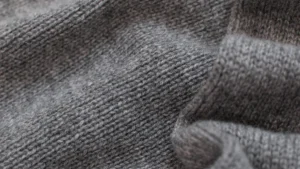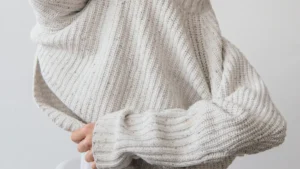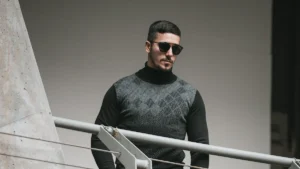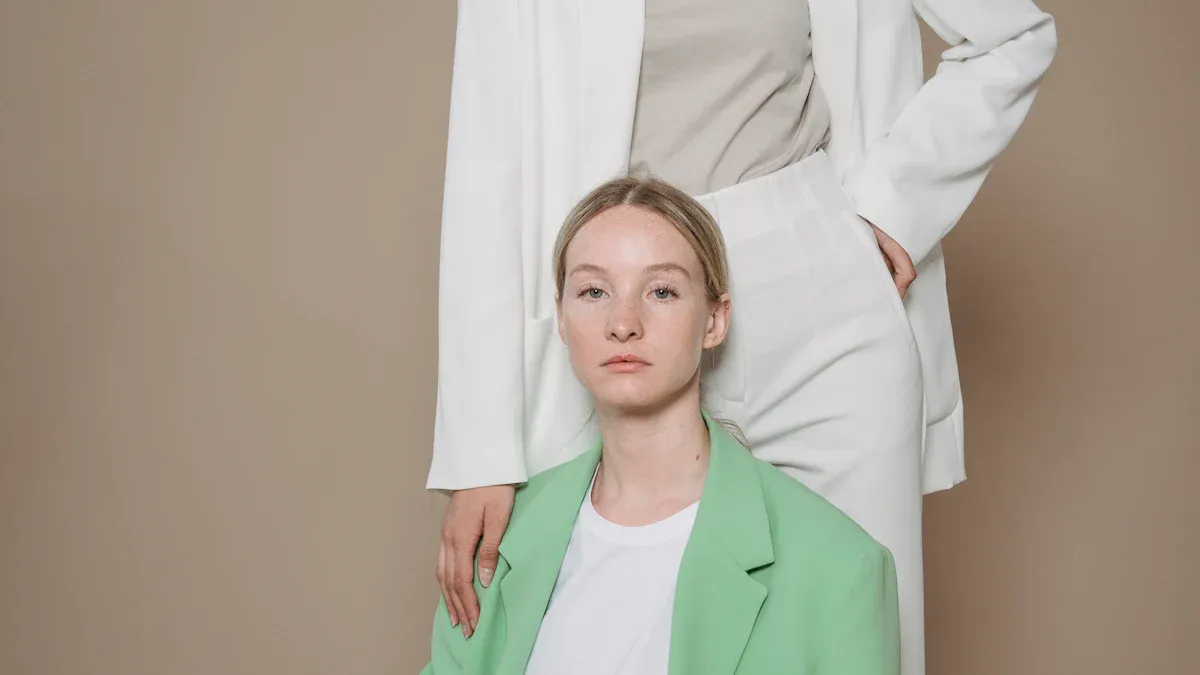
If you have ever wondered what is a double knit blazer, you are not alone. A double knit blazer uses a special fabric that feels soft like a sweater but looks sharp like a classic blazer. When you wear this blazer, you get both comfort and style. The fabric stretches a little, so you can move easily. If you ask what is a double knit blazer, just think of a blazer that feels cozy but looks neat for any occasion.
Tip: Choose a double knit blazer when you want to look polished but feel relaxed.
Key Takeaways
A double knit blazer looks sharp like a classic blazer but feels soft and stretchy because of the knit fabric.
The double knit fabric has two layers. This makes the blazer strong, keeps its shape, and stops wrinkles.
Double knit blazers are more comfortable and flexible than woven blazers. They also last longer than single knit blazers.
These blazers are easy to take care of. You can usually wash them in a machine. They do not wrinkle easily, so they are great for daily use and travel.
You can wear double knit blazers for fancy or casual events. Just change your accessories and clothes to match the occasion.
What is a double knit blazer
A double knit blazer is a jacket that gives you the best of both worlds. You get the sharp, tailored look of a classic blazer, but you also enjoy the comfort and stretch of a soft knit fabric. When you ask what is a double knit blazer, think of a piece that feels cozy like your favorite sweater but looks polished enough for work or special events. The secret lies in the fabric. Double knit fabric has two layers that are woven together, making it thicker, firmer, and more stable than other knits. This structure helps the blazer keep its shape and last longer, even with regular wear.
Key Features
You will notice several features that make a double knit blazer stand out:
Heavier weight with stretch: The double knit fabric gives the blazer a bit of stretch, so you can move easily. You do not feel restricted like in some stiff jackets.
Notched collar: This classic detail works for both formal and casual settings, making your blazer more versatile.
Statement shoulder pads: These add structure and help balance your shape, giving you a strong, confident look.
Front patch or jetted flap pockets: These pockets are roomy and practical, letting you carry small items without losing style.
Back vent: This feature adds extra comfort and makes it easier for you to move.
Unlined construction: Many double knit blazers skip the lining, which keeps them breathable and comfortable.
Machine washable: You can often wash these blazers at home, making care simple.
Note: Double knit blazers hold their shape well and rarely wrinkle, so you look neat all day.
Here is a quick look at how these features help you:
Feature | Benefit for You |
|---|---|
Double knit fabric | Keeps shape, resists wrinkles, feels comfortable |
4-way stretch | Lets you move freely |
Notched collar | Works for many occasions |
Shoulder pads | Adds structure and style |
Patch or flap pockets | Useful and stylish |
Back vent | Increases comfort |
Machine washable | Easy to care for |
How It Differs from Other Blazers
When you compare what is a double knit blazer to other types, you see some clear differences. Most traditional blazers use woven fabrics, which feel crisp and hold their shape very well. These woven blazers look sharp but can feel stiff and limit your movement. Single knit blazers use only one layer of knit fabric. They feel soft and stretchy but often curl at the edges and do not last as long.
A double knit blazer stands out because:
The double knit fabric uses two layers, making it heavier and more durable than single knits.
It does not curl at the edges, so your blazer always looks tidy.
You get more flexibility and comfort than with woven blazers, but you still keep a structured, tailored look.
Double knit blazers last longer than single knit ones and offer more stretch than woven styles.
If you want a blazer that blends comfort, durability, and style, a double knit blazer is a smart choice. You can wear it to work, dinner, or even casual outings. When someone asks you what is a double knit blazer, you can say it is a blazer made from double knit fabric that feels as good as it looks.
Double knit fabric
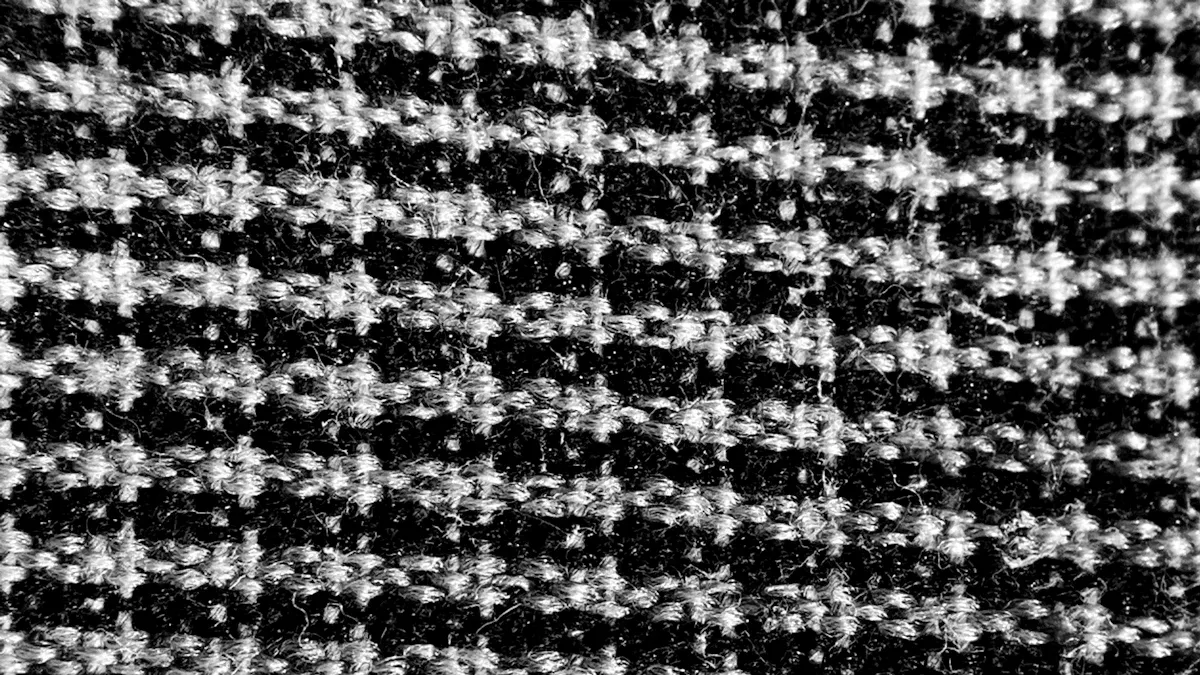
Structure and Qualities
Double knit fabric is special because of how it is made. Two sets of needles work on a knitting machine. This makes two layers of knit fabric joined together. The fabric feels thicker and firmer than most other knits. It is dense and stable, so it does not curl at the edges. This fabric keeps its shape and does not wrinkle much. That is why it works well for blazers.
Here are some things you will notice about double knit fabrics:
They feel heavier because of the two layers.
The fabric stays in shape and does not stretch out.
It has some stretch, so your blazer feels comfy and moves with you.
Double knit fabric can look nice on both sides.
The thickness helps the blazer cover lines from undergarments.
The dense fabric gives a crisp look, like woven jackets.
Tip: Double knit polyester and double knit cotton blends make your blazer even stronger and more comfortable.
Common Types
There are many types of double knit fabrics used for blazers. Some popular ones are interlocks, rib knits, Ponte di Roma, and double-knit jacquards. Interlock fabrics are smooth on both sides. Rib knits stretch more side to side and look the same on both faces. Ponte di Roma, or ponte knit, is thick and firm with small ribs going across. These double-faced fabrics are great for blazers that need structure.
Blazers often use fiber blends for comfort, stretch, and strength. Here are some common blends and what they do:
Rayon makes the fabric soft and smooth.
Polyester makes it strong and helps stop wrinkles.
Nylon adds extra strength.
Spandex (or elastane) gives stretch for easy movement.
You might also see blends like double knit polyester, double knit cotton, or even wool or cashmere for warmth and a fancy feel. The table below shows some popular blends used for making blazers:
Composition (Fiber Blend) | Weight (gsm) | Notes on Suitability for Blazers |
|---|---|---|
48.7% Polyester, 36.2% Viscose, 13.8% Nylon, 1.3% Spandex | 480 | Dense, elastic, wrinkle resistant, structured |
55% Cotton, 45% Polyester | 420 | Durable, comfortable, common for blazers |
96% Polyester, 4% Spandex | 400 | Durable, wrinkle resistant |
5% Wool, 31% Tencel, 49% Polyester, 15% Spandex | 400 | Warm, structured, ideal for blazers |
19.5% Viscose, 17.5% Acrylic, 2% Silk, 12% Spandex, 49% Polyester | 400 | Soft, elastic, luxurious feel |
60% Cotton, 40% Polyester | 380 | Balanced comfort and durability |
95% Cotton, 5% Polyester | 360 | Breathable, strong |
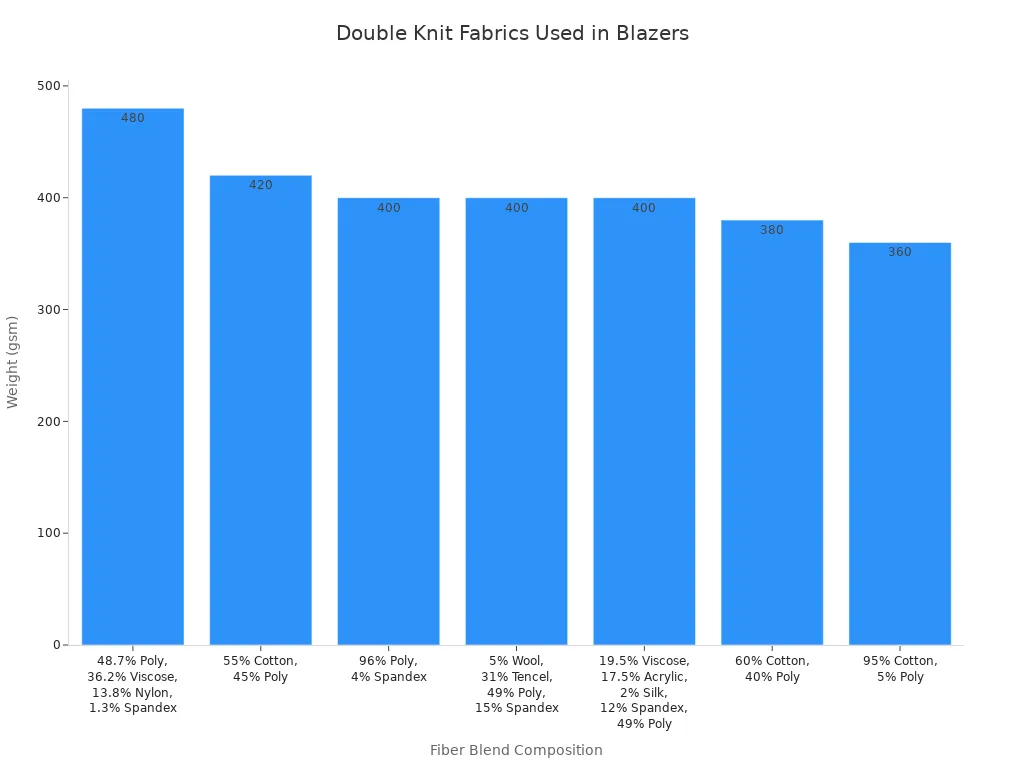
Double knit fabrics give you structure, comfort, and style. If you pick a blazer made from this fabric, you get something that looks neat and feels good all day.
How double knit fabric is made
Knitting Process
You may wonder how double knit fabric gets its special feel. The process starts with knitting machines made just for this job. These machines have two sets of needles that work together. They make two layers of fabric at the same time. The layers join, so the fabric is thicker and stronger.
Here are the main machines used to make double knit fabric for blazers:
Double Jersey Circular Knitting Machines have two sets of needles. These are called cylinder and dial needles. They sit at right angles to each other.
Rib Circular Knitting Machines make ribbed textures. They do this by switching between face and back loops.
Interlock Circular Knitting Machines form loops in two ways. This makes the fabric smooth and strong.
These machines can make many patterns and textures. The fabric does not curl at the edges. It keeps its shape very well. Circular knitting machines are often used for jacket, suit, and blazer fabrics. When you pick a double knit blazer, you get the benefits of this careful process.
Tip: The double knit process gives you fabric that feels soft but stays firm. This is great for comfort and style.
Materials Used
The fibers in double knit fabric change how your blazer feels and lasts. Makers often mix different fibers for comfort, stretch, and strength. Here is a table that shows how each fiber type changes your blazer:
Fiber | Performance Characteristics | Care Considerations |
|---|---|---|
Polyester | Durable, moisture-wicking, quick-drying, colorfast | Low maintenance, resists pilling |
Nylon | Strong, abrasion-resistant, elastic, quick-drying | Durable, heat sensitivity varies |
Spandex | Exceptional stretch and shape retention | Heat sensitive, requires careful laundering |
Cotton | Comfortable, soft, breathable | Prone to shrinking, less elastic |
Bamboo | Soft, antibacterial, moisture-wicking | Requires specific care for longevity |
Wool | Insulating, temperature regulating, odor-resistant | Prone to shrinkage if improperly cared for |
Double knit polyester is common in blazers. It does not wrinkle and keeps its color. Double knit cotton feels soft and lets air in, so it is comfy. Mixing fibers like polyester, cotton, and spandex helps your blazer stay strong and stretchy. It also makes it easy to care for. The right fiber mix means your double knit blazer will look nice and feel good for a long time.
Blazer construction
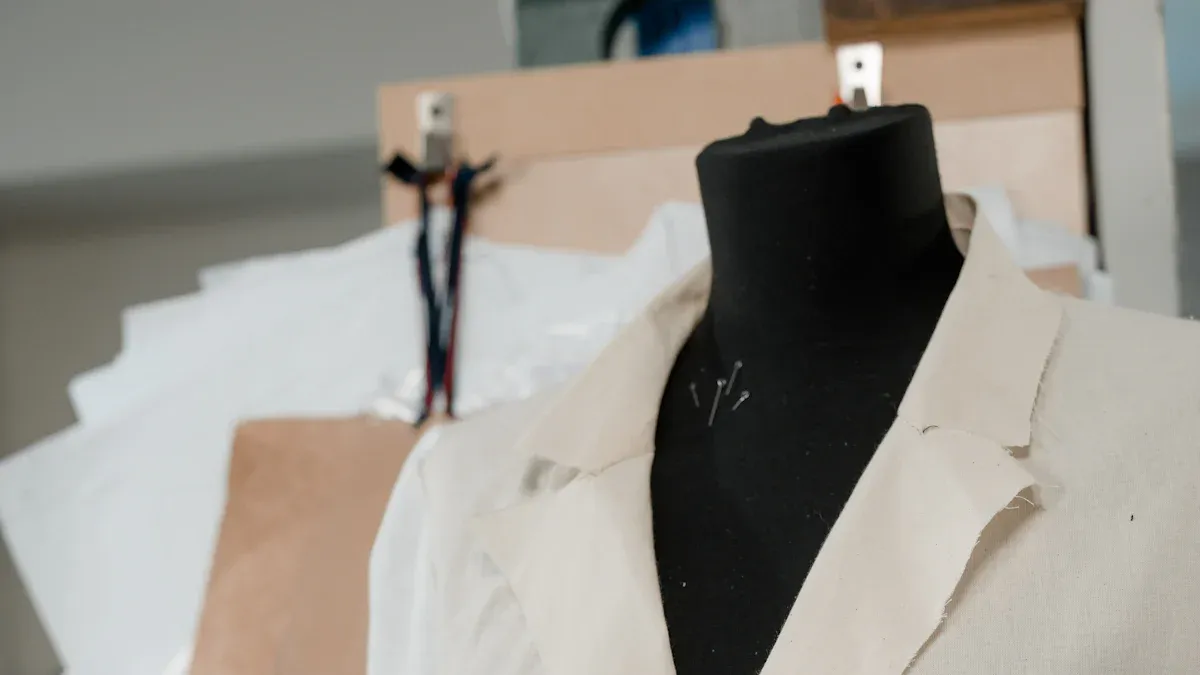
Cutting and Sewing
Turning double knit fabric into a blazer takes careful planning and skill. You start by choosing a pattern that matches the style and fit you want. Double knit fabric works best with patterns made for stable, stretchy materials. Before you cut, you mark a 3/8″ seam allowance and add dots at key points like the shoulders, collar, and pocket corners. This helps you sew each part of the blazer with accuracy.
Here are the main steps you follow to cut and sew a double knit blazer:
Pick a medium to heavyweight double knit fabric with at least 25% horizontal stretch. This gives your blazer structure and comfort.
Mark seam allowances and important points on the fabric.
Stabilize areas like the shoulders and collar with interfacing. Stay stitching helps manage corners and keeps the fabric from stretching out.
Cut the fabric pieces, trimming seam allowances to 1/4 or 3/8 inch to avoid bulky seams.
Sew the main body, handling darts and seams carefully to keep the blazer’s shape.
Attach the collar in two steps: first, baste the main collar to the neckline, then sew the facing layer. Sometimes, you hand sew at corners to prevent puckering.
Use understitching on the neckline for a clean look. Snip seam allowances at the collar break point to help seams lay flat.
Hem the blazer using a single turned hem or a twin needle for stretchier areas.
Tip: Test your stitches on scrap fabric before sewing the blazer. This helps you find the best stitch type and width for your double knit fabric.
Finishing Details
Finishing touches make your blazer look sharp and last longer. You use interfacing to support the fabric, especially at the front, collar, and pocket areas. Shoulder pads and sleeve heads give the blazer its classic shape and help it keep form over time.
To keep seams strong and neat, you can use a serger or overedge stitch. This stops the fabric from unraveling and adds durability. Stay-taping the shoulder seams prevents stretching, so your blazer keeps its shape. Pressing seam allowances carefully gives your blazer a crisp, professional look.
You may choose to line the blazer fully, partially, or not at all. Silk linings feel smooth and add a touch of luxury. For extra strength, reinforce the front facings, line the pockets, and use tape under the arms. Self-enclosed seam finishes, like French seams, work well for unlined blazers and keep raw edges hidden.
The double knit fabric itself helps your blazer resist sagging and stretching. Its thickness and stability mean your blazer will hold its tailored look, even after many wears. By following these steps, you create a blazer that feels comfortable, looks polished, and stands up to daily use.
Blazer care and styling
Care Tips
Taking care of your blazer helps it last longer and keeps it looking sharp. Double knit blazers are easier to care for than traditional wool or linen jackets. You can often machine wash them, but always check the care label first.
Use a gentle cycle with cold water and a mild detergent made for wool or delicate fabrics.
For wool or cashmere blends, hand wash in cold water. Gently rub the fabric and avoid twisting or soaking for too long.
Dry your blazer flat on a towel. Hanging it while wet can stretch the fabric and change its shape.
Iron your blazer inside out at a low temperature (no more than 110°C) to avoid damaging the fibers.
Store your blazer folded or flat on a shelf. Hanging it for long periods can cause it to lose its shape.
Use a lint remover to keep your blazer looking neat. If you see loose threads, cut them or pull them gently inside.
Keep your blazer clean before storing it. Use lavender bags or mothballs to protect against pests.
Tip: Between washes, refresh your blazer with gentle steam and hang it in a garment bag away from sunlight and dust.
Here is a quick care guide:
Care Aspect | Recommendation |
|---|---|
Washing | Machine wash cold or hand wash; use gentle detergent |
Drying | Dry flat; avoid hanging when wet |
Storing | Fold or store flat; avoid long-term hanging |
Maintenance | Remove lint; handle loose threads carefully |
Pest Control | Store clean; use lavender bags or mothballs |
Styling Ideas
You can style your blazer for many occasions. For a formal look, wear your blazer with tailored pants or a pencil skirt and add heels. This creates a polished outfit for work or special events. For casual days, pair your blazer with jeans and a simple t-shirt. Sneakers or loafers keep the look relaxed but stylish.
Try these ideas to change up your blazer style:
Use a belt to cinch an oversized blazer at the waist for a trendy shape.
In summer, choose lighter shirts and loafers. In winter, layer your blazer over a wool sweater and wear boots.
Pick classic colors like navy or black for formal events. For casual outings, try bold colors or patterns.
Add a silk pocket square or a handmade tie for a dressy touch. For a fun look, roll up the sleeves or add a statement bag.
Mix your blazer with different textures, like denim or knitwear, to create a unique outfit.
Note: Your blazer works for both business meetings and weekend outings. Change your accessories and shoes to match the occasion.
A double knit blazer is comfy and stylish. It is easy to take care of. The fabric stretches and does not wrinkle much. It looks neat and feels soft on your skin. Many people like these blazers because they are:
Stylish and fit well for comfort
Easy to wash in a machine or by hand
Good for work or just hanging out
Strong and keeps you warm
Key Features | Why Try It? | |
|---|---|---|
Ponte Knit Blazer | Stretch, tailored silhouette | Good for people new to blazers |
Relaxed-Fit Knit | Soft, modern shape | Feels comfy but still looks nice |
You can find more tips and care ideas on websites like CorporetteMoms and CareOfCarl. Try wearing a double knit blazer to feel good and look nice every day!
FAQ
What makes a double knit blazer different from a regular blazer?
You get more stretch and comfort with a double knit blazer. The fabric feels thicker and softer than most woven blazers. You can move easily and still look sharp. Double knit blazers also resist wrinkles better than regular blazers.
Can you wear a double knit blazer year-round?
Yes, you can wear it in every season. The fabric keeps you warm in cool weather. It also breathes well, so you stay comfortable in warmer months. Layer it with shirts or sweaters for extra warmth.
How do you know if your blazer is double knit?
Check the fabric. Double knit feels thicker and stretches in both directions. The edges do not curl. You can also look at the care label. It may list “double knit,” “ponte,” or “interlock” as the fabric type.
Is a double knit blazer good for travel?
Yes! You can pack it in your bag, and it will not wrinkle much. The fabric bounces back to shape. You look neat after unpacking. Many double knit blazers are also machine washable, which makes them easy to care for on the go.




